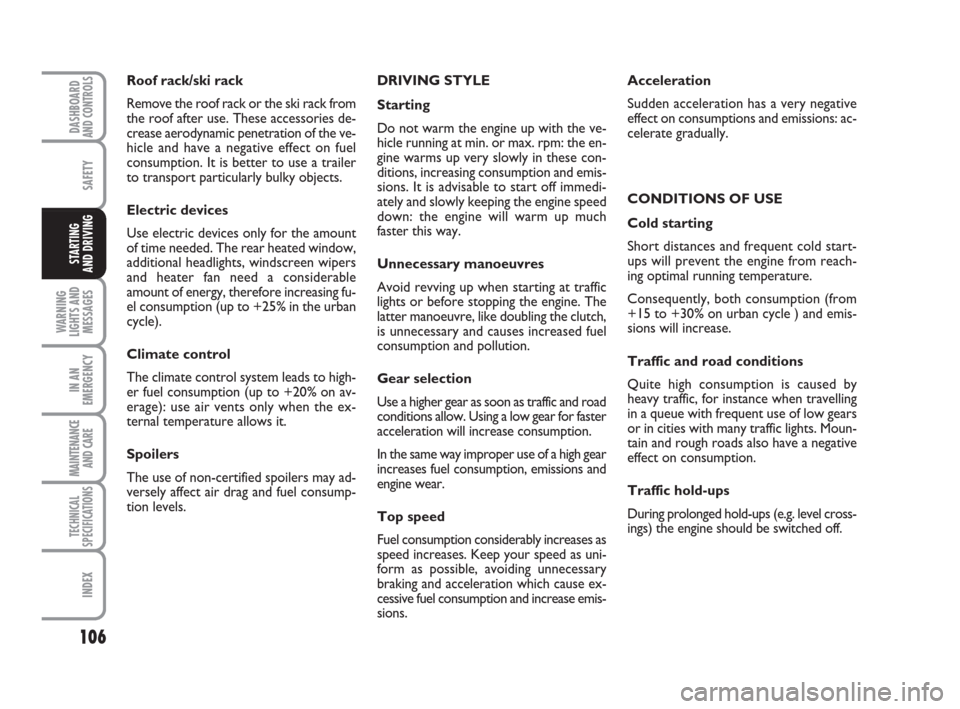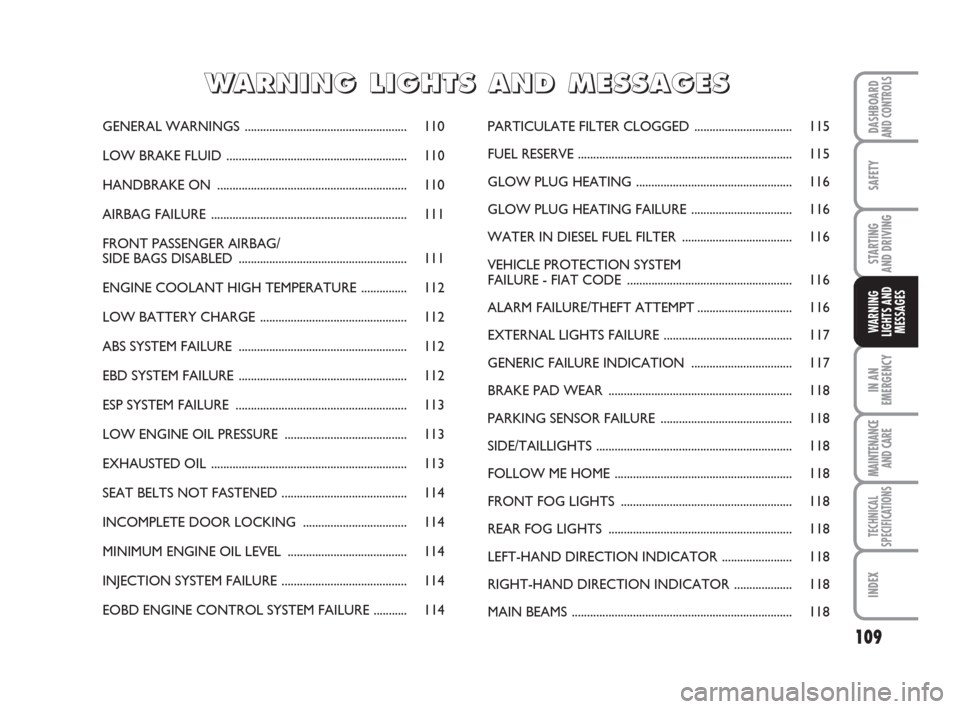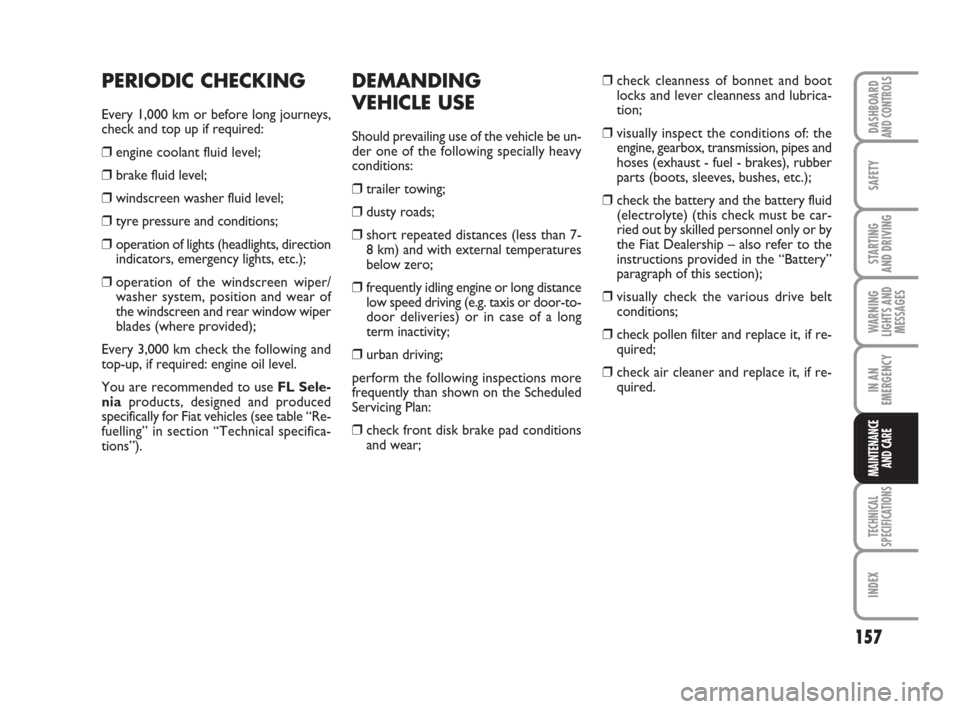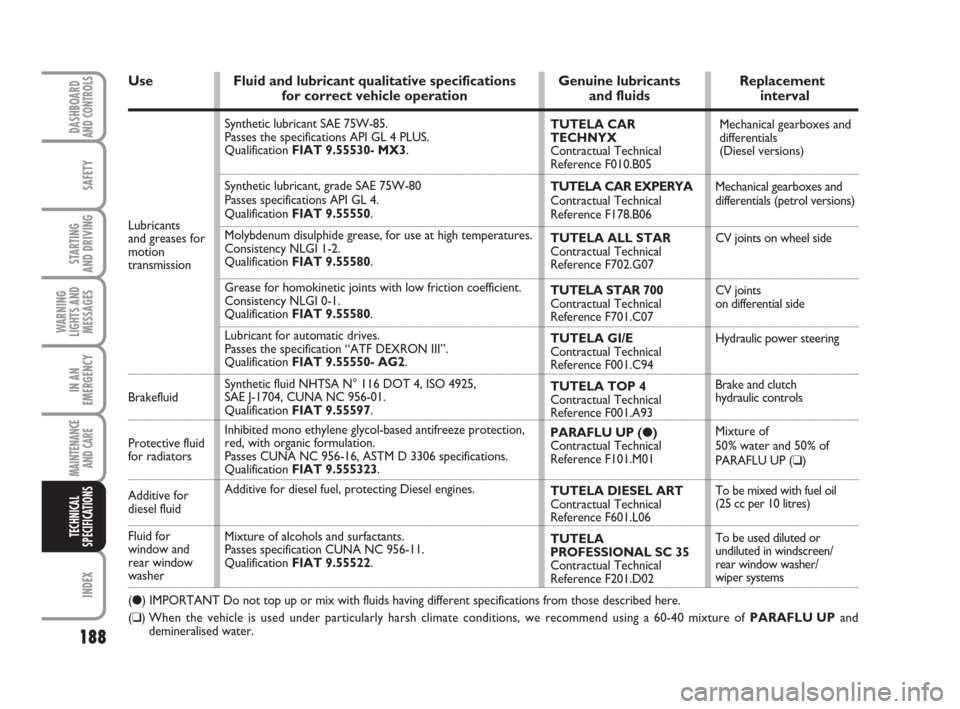oil temperature FIAT QUBO 2008 1.G Owners Manual
[x] Cancel search | Manufacturer: FIAT, Model Year: 2008, Model line: QUBO, Model: FIAT QUBO 2008 1.GPages: 202, PDF Size: 3.43 MB
Page 107 of 202

106
SAFETY
WARNING
LIGHTS AND
MESSAGES
IN AN
EMERGENCY
MAINTENANCE
AND CARE
TECHNICAL
SPECIFICATIONS
INDEX
DASHBOARDAND CONTROLS
STARTING
AND DRIVING
Roof rack/ski rack
Remove the roof rack or the ski rack from
the roof after use. These accessories de-
crease aerodynamic penetration of the ve-
hicle and have a negative effect on fuel
consumption. It is better to use a trailer
to transport particularly bulky objects.
Electric devices
Use electric devices only for the amount
of time needed. The rear heated window,
additional headlights, windscreen wipers
and heater fan need a considerable
amount of energy, therefore increasing fu-
el consumption (up to +25% in the urban
cycle).
Climate control
The climate control system leads to high-
er fuel consumption (up to +20% on av-
erage): use air vents only when the ex-
ternal temperature allows it.
Spoilers
The use of non-certified spoilers may ad-
versely affect air drag and fuel consump-
tion levels.DRIVING STYLE
Starting
Do not warm the engine up with the ve-
hicle running at min. or max. rpm: the en-
gine warms up very slowly in these con-
ditions, increasing consumption and emis-
sions. It is advisable to start off immedi-
ately and slowly keeping the engine speed
down: the engine will warm up much
faster this way.
Unnecessary manoeuvres
Avoid revving up when starting at traffic
lights or before stopping the engine. The
latter manoeuvre, like doubling the clutch,
is unnecessary and causes increased fuel
consumption and pollution.
Gear selection
Use a higher gear as soon as traffic and road
conditions allow. Using a low gear for faster
acceleration will increase consumption.
In the same way improper use of a high gear
increases fuel consumption, emissions and
engine wear.
Top speed
Fuel consumption considerably increases as
speed increases. Keep your speed as uni-
form as possible, avoiding unnecessary
braking and acceleration which cause ex-
cessive fuel consumption and increase emis-
sions.Acceleration
Sudden acceleration has a very negative
effect on consumptions and emissions: ac-
celerate gradually.
CONDITIONS OF USE
Cold starting
Short distances and frequent cold start-
ups will prevent the engine from reach-
ing optimal running temperature.
Consequently, both consumption (from
+15 to +30% on urban cycle ) and emis-
sions will increase.
Traffic and road conditions
Quite high consumption is caused by
heavy traffic, for instance when travelling
in a queue with frequent use of low gears
or in cities with many traffic lights. Moun-
tain and rough roads also have a negative
effect on consumption.
Traffic hold-ups
During prolonged hold-ups (e.g. level cross-
ings) the engine should be switched off.
101-108 Fiorino GB 1ed 21-10-2008 15:00 Pagina 106
Page 110 of 202

109
SAFETY
IN AN
EMERGENCY
MAINTENANCE
AND CARE
TECHNICAL
SPECIFICATIONS
INDEX
DASHBOARDAND CONTROLS
STARTING
AND DRIVING
WARNING
LIGHTS AND
MESSAGES
GENERAL WARNINGS..................................................... 110
LOW BRAKE FLUID........................................................... 110
HANDBRAKE ON.............................................................. 110
AIRBAG FAILURE................................................................ 111
FRONT PASSENGER AIRBAG/
SIDE BAGS DISABLED....................................................... 111
ENGINE COOLANT HIGH TEMPERATURE............... 112
LOW BATTERY CHARGE................................................ 112
ABS SYSTEM FAILURE....................................................... 112
EBD SYSTEM FAILURE....................................................... 112
ESP SYSTEM FAILURE ........................................................ 113
LOW ENGINE OIL PRESSURE........................................ 113
EXHAUSTED OIL................................................................ 113
SEAT BELTS NOT FASTENED......................................... 114
INCOMPLETE DOOR LOCKING.................................. 114
MINIMUM ENGINE OIL LEVEL....................................... 114
INJECTION SYSTEM FAILURE......................................... 114
EOBD ENGINE CONTROL SYSTEM FAILURE ........... 114PARTICULATE FILTER CLOGGED................................ 115
FUEL RESERVE...................................................................... 115
GLOW PLUG HEATING................................................... 116
GLOW PLUG HEATING FAILURE................................. 116
WATER IN DIESEL FUEL FILTER.................................... 116
VEHICLE PROTECTION SYSTEM
FAILURE - FIAT CODE ...................................................... 116
ALARM FAILURE/THEFT ATTEMPT............................... 116
EXTERNAL LIGHTS FAILURE.......................................... 117
GENERIC FAILURE INDICATION................................. 117
BRAKE PAD WEAR............................................................ 118
PARKING SENSOR FAILURE........................................... 118
SIDE/TAILLIGHTS................................................................ 118
FOLLOW ME HOME.......................................................... 118
FRONT FOG LIGHTS........................................................ 118
REAR FOG LIGHTS............................................................ 118
LEFT-HAND DIRECTION INDICATOR....................... 118
RIGHT-HAND DIRECTION INDICATOR................... 118
MAIN BEAMS........................................................................ 118
W W
A A
R R
N N
I I
N N
G G
L L
I I
G G
H H
T T
S S
A A
N N
D D
M M
E E
S S
S S
A A
G G
E E
S S
109-118 Fiorino GB 1ed 21-10-2008 15:00 Pagina 109
Page 158 of 202

157
SAFETY
TECHNICAL
SPECIFICATIONS
INDEX
DASHBOARDAND CONTROLS
STARTING
AND DRIVING
WARNING
LIGHTS AND
MESSAGES
IN AN
EMERGENCY
MAINTENANCE
AND CARE
PERIODIC CHECKING
Every 1,000 km or before long journeys,
check and top up if required:
❒engine coolant fluid level;
❒brake fluid level;
❒windscreen washer fluid level;
❒tyre pressure and conditions;
❒operation of lights (headlights, direction
indicators, emergency lights, etc.);
❒operation of the windscreen wiper/
washer system, position and wear of
the windscreen and rear window wiper
blades (where provided);
Every 3,000 km check the following and
top-up, if required: engine oil level.
You are recommended to use FL Sele-
niaproducts, designed and produced
specifically for Fiat vehicles (see table “Re-
fuelling” in section “Technical specifica-
tions”).
DEMANDING
VEHICLE USE
Should prevailing use of the vehicle be un-
der one of the following specially heavy
conditions:
❒trailer towing;
❒dusty roads;
❒short repeated distances (less than 7-
8 km) and with external temperatures
below zero;
❒frequently idling engine or long distance
low speed driving (e.g. taxis or door-to-
door deliveries) or in case of a long
term inactivity;
❒urban driving;
perform the following inspections more
frequently than shown on the Scheduled
Servicing Plan:
❒check front disk brake pad conditions
and wear;❒check cleanness of bonnet and boot
locks and lever cleanness and lubrica-
tion;
❒visually inspect the conditions of: the
engine, gearbox, transmission, pipes and
hoses (exhaust - fuel - brakes), rubber
parts (boots, sleeves, bushes, etc.);
❒check the battery and the battery fluid
(electrolyte) (this check must be car-
ried out by skilled personnel only or by
the Fiat Dealership – also refer to the
instructions provided in the “Battery”
paragraph of this section);
❒visually check the various drive belt
conditions;
❒check pollen filter and replace it, if re-
quired;
❒check air cleaner and replace it, if re-
quired.
151-172 Fiorino GB 1ed 21-10-2008 15:01 Pagina 157
Page 189 of 202

188
SAFETY
INDEX
DASHBOARDAND CONTROLS
STARTING
AND DRIVING
WARNING
LIGHTS AND
MESSAGES
IN AN
EMERGENCY
MAINTENANCE
AND CARE
TECHNICAL
SPECIFICATIONS
Lubricants
and greases for
motion
transmission
Use Fluid and lubricant qualitative specifications Genuine lubricants Replacementfor correct vehicle operation and fluids interval
(●) IMPORTANT Do not top up or mix with fluids having different specifications from those described here.
(❑) When the vehicle is used under particularly harsh climate conditions, we recommend using a 60-40 mixture ofPARAFLU UPand
demineralised water.Synthetic lubricant SAE 75W-85.
Passes the specifications API GL 4 PLUS.
Qualification FIAT 9.55530- MX3.
Synthetic lubricant, grade SAE 75W-80
Passes specifications API GL 4.
Qualification FIAT 9.55550.
Molybdenum disulphide grease, for use at high temperatures.
Consistency NLGI 1-2.
Qualification FIAT 9.55580.
Grease for homokinetic joints with low friction coefficient.
Consistency NLGI 0-1.
Qualification FIAT 9.55580.
Lubricant for automatic drives.
Passes the specification “ATF DEXRON III”.
Qualification FIAT 9.55550- AG2.
Synthetic fluid NHTSA N° 116 DOT 4, ISO 4925,
SAE J-1704, CUNA NC 956-01.
Qualification FIAT 9.55597.
Inhibited mono ethylene glycol-based antifreeze protection,
red, with organic formulation.
Passes CUNA NC 956-16, ASTM D 3306 specifications.
Qualification FIAT 9.555323.
Additive for diesel fuel, protecting Diesel engines.
Mixture of alcohols and surfactants.
Passes specification CUNA NC 956-11.
Qualification FIAT 9.55522.TUTELA CAR
TECHNYX
Contractual Technical
Reference F010.B05
TUTELA CAR EXPERYA
Contractual Technical
Reference F178.B06
TUTELA ALL STAR
Contractual Technical
Reference F702.G07
TUTELA STAR 700
Contractual Technical
Reference F701.C07
TUTELA GI/E
Contractual Technical
Reference F001.C94
TUTELA TOP 4
Contractual Technical
Reference F001.A93
PARAFLU UP (
●)
Contractual Technical
Reference F101.M01
TUTELA DIESEL ART
Contractual Technical
Reference F601.L06
TUTELA
PROFESSIONAL SC 35
Contractual Technical
Reference F201.D02Mechanical gearboxes and
differentials
(Diesel versions)
Mechanical gearboxes and
differentials (petrol versions)
CV joints on wheel side
CV joints
on differential side
Hydraulic power steering
Brake and clutch
hydraulic controls
Mixture of
50% water and 50% of
PARAFLU UP (❑)
To be mixed with fuel oil
(25 cc per 10 litres)
To be used diluted or
undiluted in windscreen/
rear window washer/
wiper systems Brakefluid
Protective fluid
for radiators
Additive for
diesel fluid
Fluid for
window and
rear window
washer
173-193 Fiorino GB 1ed 21-10-2008 15:02 Pagina 188